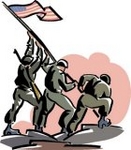
Worksheets and No Prep Teaching Resources
Reading Comprehension Worksheets
World War II

World War II
 Worksheets and No Prep Teaching Resources Reading Comprehension Worksheets World War II |
 World War II |
| edHelper's suggested reading level: | grades 6 to 8 | |
| Flesch-Kincaid grade level: | 7.2 |
|
Battle of Midway Island
By Jane Runyon |

|
 1 The American Air Force and Navy took heart after the Battle of the Coral Sea. They hadn't defeated the Japanese fleet, but they hadn't been defeated either. The Japanese had marched across the Pacific Ocean. It looked as though no one would be able to stop them. The combined forces from the United States and Great Britain and had slowed them down. They had kept the Japanese from taking over Port Moresby. This newly found confidence gave the American forces the push they needed to try and to stop the advance.
1 The American Air Force and Navy took heart after the Battle of the Coral Sea. They hadn't defeated the Japanese fleet, but they hadn't been defeated either. The Japanese had marched across the Pacific Ocean. It looked as though no one would be able to stop them. The combined forces from the United States and Great Britain and had slowed them down. They had kept the Japanese from taking over Port Moresby. This newly found confidence gave the American forces the push they needed to try and to stop the advance. |
Create Weekly Reading Books
Prepare for an entire week at once! |
| Leave your feedback on Battle of Midway Island (use this link if you found an error in the story) |
 |
World War II
|
 |
Social Studies
|
 |
United States
|
|
|
|
|
 | Fifty States Theme Unit |
 |
Document Based Activities |